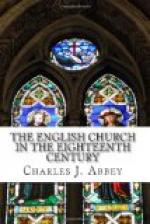It is proposed to invite, in this chapter, a more particular attention to the writings of Archbishop Tillotson. He lived and died in the seventeenth century, but is an essential part of the Church history of the eighteenth. The most general sketch of its characteristics would be imperfect without some reference to the influence which his life and teaching exercised upon it. Hallam contrasts the great popularity of his sermons for half a century with the utter neglect into which they have now fallen, as a remarkable instance of the fickleness of religious taste.[196] Something must certainly be attributed to change of taste. If Tillotson were thoroughly in accord with our own age in thought and feeling, the mere difference of his style from that which pleases the modern ear would prevent his having many readers. He is reckoned diffuse and languid, greatly deficient in vigour and vivacity. How different was the tone of criticism in the last age! Dryden considered that he was indebted for his good style to the study of Tillotson’s sermons.[197] Robert Nelson spoke of them as the best standard of the English language.[198] Addison expressed the same opinion, and thought his writing would form a proper groundwork for the dictionary which he once thought of compiling.[199]
But it was not the beauty and eloquence of language with which Tillotson was at one time credited that gave him the immense repute with which his name was surrounded; neither is it a mere change of literary taste that makes a modern reader disinclined to admire, or even fairly to appreciate, his sermons. He struck the key-note which in his own day, and for two generations or more afterwards, governed the predominant tone of religious reasoning and sentiment. In the substance no less than in the form of his writings men found exactly what suited them—their own thoughts raised to a somewhat higher level, and expressed just in the manner which they would most aspire to imitate. His sermons, when delivered, had been exceedingly popular. We are told of the crowds of auditors and the fixed attention with which they listened, also of the number of clergymen who frequented his St. Laurence lectures, not only for the pleasure of hearing, but to form their minds and improve their style. He was, in fact, the great preacher of his time. Horace Walpole, writing in 1742, compared the throngs who flocked to hear Whitefield to the concourse which used to gather when Tillotson preached.[200] The literature of the eighteenth century abounds in expressions of respect for his character and admiration of his sermons. Samuel Wesley said that he had brought the art of preaching ’near perfection, had there been as much of life as there is of politeness and generally of cool, clear, close reasoning and convincing arguments.’[201] Even John Wesley puts him in the very foremost rank of great preachers.[202] Robert Nelson specially recommended his sermons to his nephew ’for true notions of




